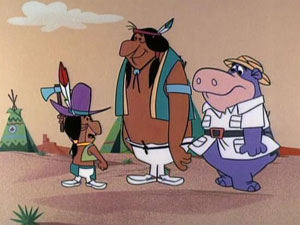Peter Potamus was a syndicated series divided into three segments; one of Peter Potamus and So-So, one of Breezly and Sneezly, and one of Yippee, Yappee and Yahooey.
It featured Peter Potamus the hippopotamus (voiced by Daws Butler impersonating Joe E. Brown) and his sidekick, So-So the monkey (voiced by Don Messick). Peter was big, purple, and friendly. Episodes generally consisted of Peter and So-So exploring the world in his time-traveling hot air balloon. When faced with a certain situation, Peter uses his Hippo Hurricane Holler technique to blow away his opponents.
Despite what you see, the cartoon isn't all bad. The Indians have brown rather than reddish skin. They use rifles as well as bows and arrows. There's no chief in a feather headdress.

On the other hand, they're half-naked, wear warpaint, and use tomahawks. They have big cartoon noses and talk in Tonto-speak. They live in teepees in the barren cactus-and-mesa Southwest, where there weren't any teepees.
The chief's Navajo-style hat is another cliché. It's what cartoonists use to indicate a traditional Indian who is important but not necessarily a chief. If you want to avoid the stereotypical headdress, this is the next best thing.
Perhaps the only good thing about this cartoon is the ending. The wagon master announces that the wagon train is headed to Hollywood to appear in a TV show. Hearing this, the Indians say they want to be in television too. They put on sunglasses, hop into a convertible, and drive off.
Showing Indians interested in mainstream things like cars and stardom is practically revolutionary. For all I know, this is the first time anyone has depicted an Indian driving a car. It's too little, too late to outweigh the cartoon's message, but it's a nice touch.
Breezly and Sneezly
The same DVD includes Missile Fizzle, a Breezly and Sneezly cartoon from the third episode. The protagonists, a polar bear and a seal, normally hang out at a US Army base in the Arctic. In this episode, the colonel kicks Breezly off the base for harming military discipline. He returns to the home he shares with Sneezly: an igloo.
This is only a brief interlude, but the message is similar to Wagon Train Strain's. They inhabit the wilderness where "civilized" white men rarely venture. They live in strange quarters--a teepee or igloo--while white men live in buildings with four walls and a roof. In short, Native people are primitive, uncivilized, and savage.
Hanna Barbera made these cartoons in 1964, remember. They featured white men as explorers, scientists, astronauts (e.g., The Jetsons). But the only people of color were an occasional south-of-the-border peasant, a Fu Manchu-style villain, and savage Indians.
This was only five years before Indian activists occupied Alcatraz. These people were gainfully employed, college educated, modern people in jackets and jeans. Yet to most Americans, they were invisible. Or worse, frozen in time like flies in amber. Americans considered Indians to be like cavemen and dinosaurs (e.g., The Flintstones): a colorful relic of the past.
For more on the subject, see:
Indians in Porky Pig Show #3
Tom and Jerry in Two Little Indians
Cool Cat in Injun Trouble
Lippy and Hardy in Injun Trouble
Porky Pig in Wagon Heels


No comments:
Post a Comment